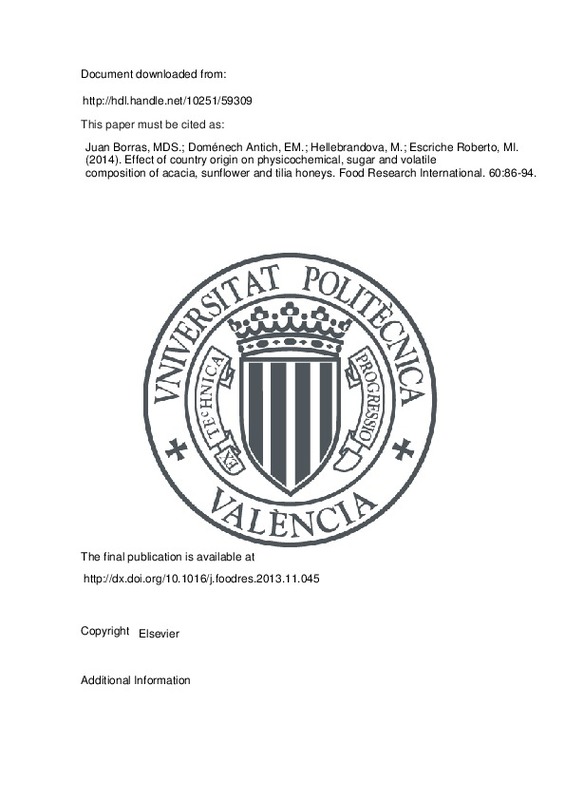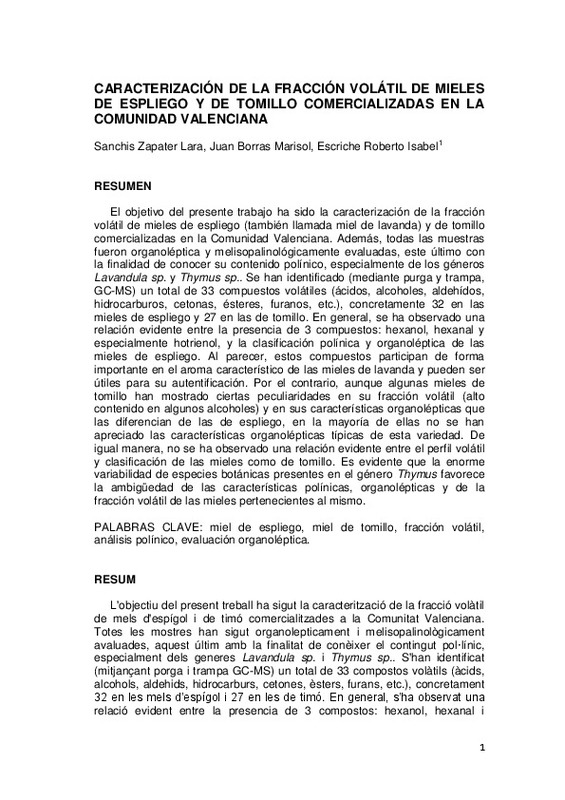Kadar, MA.; Juan Borrás, MDS.; Carot Sierra, JM.; Doménech Antich, EM.; Escriche Roberto, MI. (2011). Volatile fraction composition and physicochemical parameters as tools for the differentiation of lemon blossom honey and orange blossom honey. Journal of the Science of Food and Agriculture. 91(15):2768-2776. https://doi.org/10.1002/jsfa.4520
Por favor, use este identificador para citar o enlazar este ítem: http://hdl.handle.net/10251/70638
|
Título:
|
Volatile fraction composition and physicochemical parameters as tools for the differentiation of lemon blossom honey and orange blossom honey
|
|
Autor:
|
Kadar, Melinda Andreea

 Juan Borrás, María del Sol
Juan Borrás, María del Sol

 Carot Sierra, José Miguel
Carot Sierra, José Miguel

 Doménech Antich, Eva Mª
Doménech Antich, Eva Mª

 Escriche Roberto, Mª Isabel
Escriche Roberto, Mª Isabel
|
|
Entidad UPV:
|
Universitat Politècnica de València. Departamento de Tecnología de Alimentos - Departament de Tecnologia d'Aliments
Universitat Politècnica de València. Departamento de Estadística e Investigación Operativa Aplicadas y Calidad - Departament d'Estadística i Investigació Operativa Aplicades i Qualitat
Universitat Politècnica de València. Instituto Universitario de Ingeniería de Alimentos para el Desarrollo - Institut Universitari d'Enginyeria d'Aliments per al Desenvolupament
|
|
Fecha difusión:
|
|
|
Resumen:
|
Background: Volatile fraction profile and physicochemical parameters were studied with the aim of evaluating their effectiveness for the differentiation between lemon blossom honey (Citrus limon L.) and orange blossom honey ...[+]
Background: Volatile fraction profile and physicochemical parameters were studied with the aim of evaluating their effectiveness for the differentiation between lemon blossom honey (Citrus limon L.) and orange blossom honey (Citrus spp.). They would be useful complementary tools to the traditional analysis based on the percentage of pollen. Results: A stepwise discriminant analysis constructed using 37 volatile compounds (extracted by purge and trap and analysed by gas chromatography-mass spectrometry), and physicochemical and colour parameters (diastase, conductivity, Pfund colour and CIE L *a *b *) together provided a model that permitted the correct classification of 98.3% of the original and 96.6% of the cross-validated cases, indicating its efficiency and robustness. This model proved its effectiveness in the differentiation of both types of honey with another set of batches from the following year. Conclusion: This model, developed from the volatile compounds, physicochemical and colour parameters, has been useful for the differentiation of lemon and orange blossom honeys. Furthermore, it may be of particular interest for the attainment of a suitable classification of orange honey in which the pollen count is very low. These capabilities imply an evident marketing advantage for the beekeeping sector, since lemon blossom honey could be commercialized as unifloral honey and not as generic citrus honey and orange blossom honey could be correctly characterized. © 2011 Society of Chemical Industry.
[-]
|
|
Palabras clave:
|
Lemon blossom honey
,
Melissopalynological analysis
,
Orange blossom honey
,
Physicochemical parameters
,
Volatile compounds
,
Volatile organic compound
,
Article
,
Chemistry
,
Citrus
,
Classification
,
Color
,
Comparative study
,
Cytology
,
Flower
,
Honey
,
Pollen
,
Statistical model
,
Sweet orange
,
Validation study
,
Citrus sinensis
,
Flowers
,
Models, Statistical
,
Volatile Organic Compounds
,
Citrus limon
|
|
Derechos de uso:
|
Cerrado |
|
Fuente:
|
Journal of the Science of Food and Agriculture. (issn:
0022-5142
)
|
|
DOI:
|
10.1002/jsfa.4520
|
|
Editorial:
|
Wiley
|
|
Versión del editor:
|
https://dx.doi.org/10.1002/jsfa.4520
|
|
Código del Proyecto:
|
info:eu-repo/grantAgreement/GVA//CV2007-244/
info:eu-repo/grantAgreement/UPV//PAID-05-08-3703/
|
|
Agradecimientos:
|
This study forms part of a project funded by the Conselleria de Empresa, Educacion y Ciencia de la Comunidad Valenciana (Valencian Regional Ministry of Business, Education, and Science; project number CV2007-244) and ...[+]
This study forms part of a project funded by the Conselleria de Empresa, Educacion y Ciencia de la Comunidad Valenciana (Valencian Regional Ministry of Business, Education, and Science; project number CV2007-244) and Universidad Politecnica de Valencia project (PAID-05-08-3703), which the authors gratefully acknowledge.
[-]
|
|
Tipo:
|
Artículo
|






![[Cerrado]](/themes/UPV/images/candado.png)




